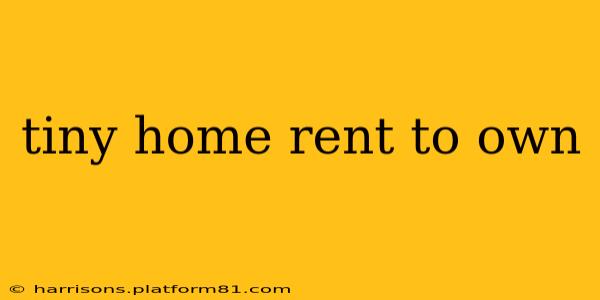The dream of owning a home is often overshadowed by the daunting costs and complexities of traditional mortgages. Enter the tiny home movement, offering a potentially more accessible route to homeownership through rent-to-own agreements. But is it truly a smart financial decision? This comprehensive guide explores the nuances of tiny home rent-to-own programs, addressing common questions and helping you decide if this path aligns with your financial goals.
What is a Tiny Home Rent to Own Program?
A tiny home rent-to-own program functions similarly to a traditional rent-to-own arrangement, but with the unique scale and often more affordable price point of a tiny home. You'll typically pay monthly rent, a portion of which goes towards the eventual purchase price of the home. The agreement outlines a specific timeframe, often several years, during which you'll build equity and eventually own the tiny home outright. Crucially, the terms are detailed in a legally binding contract, clearly defining responsibilities and payment schedules for both parties.
How Does a Tiny Home Rent to Own Program Differ from a Traditional Mortgage?
Unlike a traditional mortgage where you borrow a large sum of money upfront, a rent-to-own program often requires a smaller down payment or initial investment. Monthly payments are usually lower, and the overall purchase price is significantly reduced due to the smaller size of the home. However, you’ll typically pay more overall than with a traditional mortgage, and the interest rate may be higher. The key difference lies in accessibility; it offers a lower barrier to entry for those struggling to meet traditional mortgage requirements.
What are the Advantages of Tiny Home Rent to Own?
- Lower upfront costs: Significantly less capital is needed to begin the homeownership journey compared to purchasing a larger home with a traditional mortgage.
- Reduced monthly payments: Smaller homes generally translate to lower property taxes and utility bills, leading to more manageable monthly payments.
- Building equity gradually: A portion of your monthly rent contributes to the home's purchase price, enabling you to slowly build equity.
- Potential for faster homeownership: The timeframe to own the home outright might be shorter than saving for a large down payment on a traditional home.
What are the Disadvantages of Tiny Home Rent to Own?
- Higher overall cost: While monthly payments might be lower, you'll likely pay more overall than with a traditional mortgage due to the higher interest rates often associated with rent-to-own agreements.
- Risk of losing investment: If you fail to meet your payment obligations, you risk losing the money you've already invested.
- Limited flexibility: The contract terms are often rigid, offering less flexibility compared to a traditional mortgage.
- Potential for hidden costs: Thoroughly review the contract to avoid unexpected fees or clauses.
How Can I Find a Tiny Home Rent to Own Program?
Finding a reputable rent-to-own program requires diligent research. Start by searching online for "tiny home rent to own" in your area. Explore local real estate listings and contact tiny home builders or sellers directly. Always exercise caution and thoroughly vet any program before signing a contract.
What Should I Look for in a Tiny Home Rent to Own Contract?
Carefully examine the contract's terms and conditions, including:
- Purchase price: Ensure it's fair and competitive.
- Monthly payments: Verify their affordability within your budget.
- Length of the agreement: Determine if the timeframe aligns with your goals.
- Equity build-up: Understand how much of your rent contributes to the purchase price.
- Early buyout options: Check if there's provision for purchasing the home sooner than the agreement specifies.
- Default clauses: Understand the consequences of missed payments.
Is a Tiny Home Rent to Own Program Right for Me?
A tiny home rent-to-own program might be a suitable option if:
- You have limited savings for a down payment.
- You desire a more affordable and manageable monthly payment.
- You're comfortable with a longer-term commitment.
- You’re adaptable to a smaller living space.
However, it's crucial to weigh the potential advantages against the disadvantages and carefully analyze your financial situation and long-term goals before making a decision. Consult with a financial advisor for personalized guidance.
What are the typical costs involved in a tiny home rent-to-own agreement?
The costs vary dramatically depending on the location, the condition and size of the home, and the terms of the rent-to-own agreement. Expect to pay monthly rent, which will include a portion toward the purchase price, plus any property taxes, insurance, and maintenance costs specified in your contract. You should also factor in the cost of moving the tiny home to your chosen location, if necessary.
This detailed guide provides a comprehensive overview of tiny home rent-to-own programs. Remember to always conduct thorough research and seek professional financial advice before entering into any agreement. Homeownership is a significant financial commitment, and careful planning is essential.
